|
THE TOUR BELOW TAKES YOU TO THE FAMOUS
BRIDGES ACROSS THE CAEN CANAL "PEGASUS BRIDGE", AND THE RIVER
ORNE. NEXT WE DRIVE TO MERVILLE TO VISIT THE BATTERY COMPLEX.
THESE TWO OBJECTS WERE TARGETS FOR THE 6TH AIRBORNE
DIVISION.
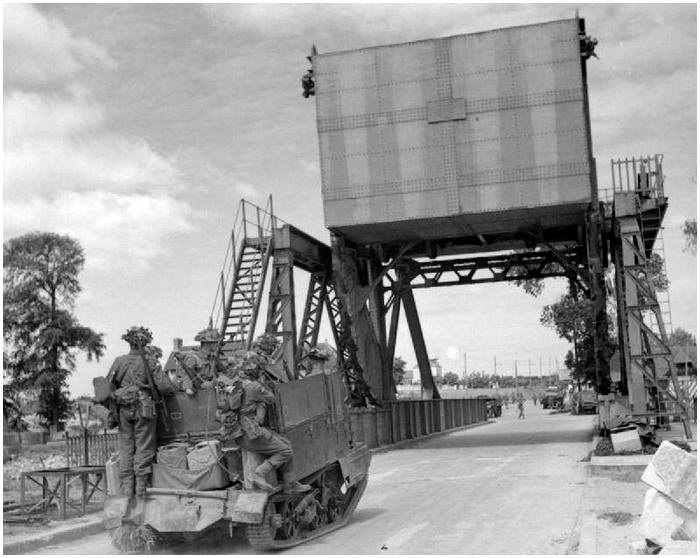
FROM BAYEUX TAKE THE N13 TO THE EAST,
DIRECTION TO CAEN. FROM CAEN (D515) HEAD FOR OUISTREHAM.
FOLLOW THE SIGNES TO BENOUVILLE/RANVILLE (D514) "PEGASUS
BRIDGE"
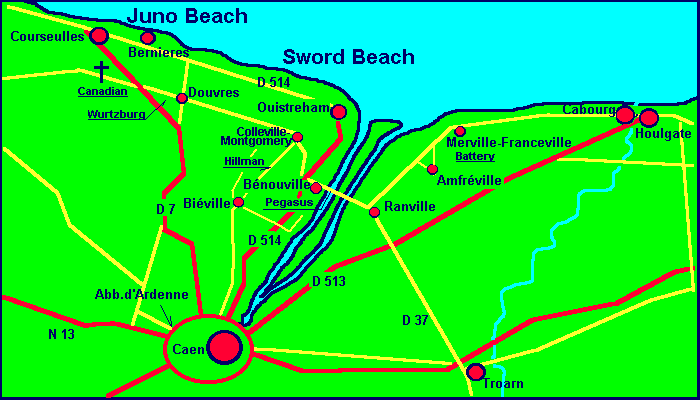
JUNE 6TH, 1944, 00.16 HOUR OBJECT:
(PEGASUS) BRIDGE OVER CAEN CANAL.
The first bridge you pass is the bridge over the Caen
canal. This is the famous Pegasus Bridge. A couple of hundred
meters further is the now called 'Horsa Bridge'. Near the Pegasus Bridge landed three 'Horsa' gliders of the 6th Airborne Division under
leadership of Major John Howard. They came down on the east bank 16
minutes after midnight on June 6th, 1944. Within 10 minutes
the bridge had fallen into D Company their hands and was secured. Within
in the British troops, there were
2 killed and 14 wounded. The owners of
café Gondrée, on the west bank, became the first French who were liberated. On the landing
side stands a bust of Major Howard and there are
marker stones were the gliders came down. The bridge at the Orne river was taken by two
other platoons of D-Company without hardly a struggle.
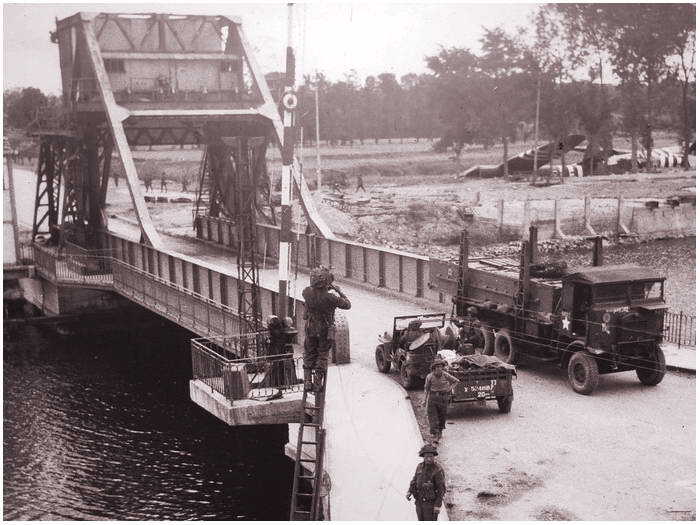 Perhaps the most famous wartime picture of Pegasus bridge
Perhaps the most famous wartime picture of Pegasus bridge
(notice the three Horsa gliders in the back)
Howard had to 'hold until relieved'. Just before daybreak
there appeared a couple of German tanks around the corner at the
maire Bénouville. With a PIAT (Projector Infantry Anti-Tank,
a grenade launcher as one is displayed in the museum) the
first tank was put out of action by sgt. Wagger Thornton. The other tanks pulled
back. All the while D Company was at the bridge it was fired upon by mortars
and snipers. The suspicion rose that it was controlled from a big building on the west shore,
the Chateau de Bénouville, a women maternity. Private Wally Parr had meanwhile figured out the
working of the German 5cm anti-tank gun, that was placed in an open bunker next to the bridge
(it is still there). He began shooting at the building. After a while Howard stopped the shooting,
because it was of no use.
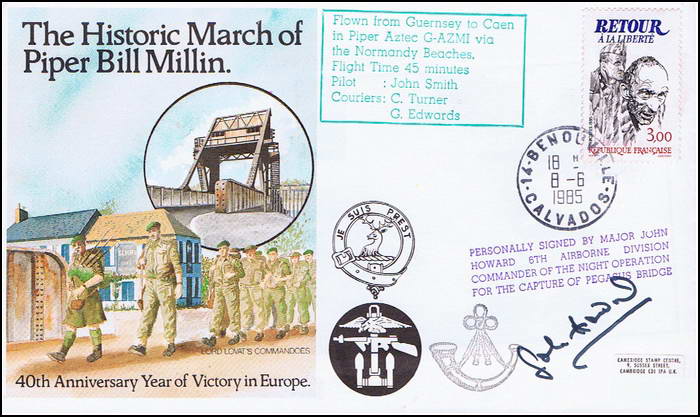 A firstday cover signed by Major John Howard
(own coll.)
A firstday cover signed by Major John Howard
(own coll.)
To the right of the building stood a watertower and they figured there
could be snipers up there. So, Parr asked permission to fire at the tower. This granted, he began
shelling it. Because he shot armoured piercing shells, they went straight through the walls of the
tower. Every hit created a new stream of water from it. After a while Howard stopped shooting at it
(the tower was torn down after the war). Around 10.00 hours a German plane dropped a bomb, which hit
the counterbalance of the bridge, but it did not detonate (the damage is still to be found at the
bridge in the museum). At 17.00 hours that afternoon the bagpipes of Bill Millin could be
heard when Lord Lovat came with his relief troops.
In 1961
this area was one of the locations for the motion picture 'The Longest Day', when the whole
attack and relief was re-enacted.

THE MEMORIAL PEGASUS MUSEUM:
Leave the (new) Pegasus Bridge and head eastwards for the Memorial Pagasus Museum.
The museum is located on the piece of land between the two bridges north of
the D514. Here you'll find the restored original bridge that
was replaced by a new one in the early nineties. In the large
counterbalance at the back of the bridge, you can still see the bruises and
holes when the bridge was struck by the German bomb. Also on show are
a Bailey bridge and a replica of a Horsa glider.
In a small shed are original pieces of a Horsa on show.
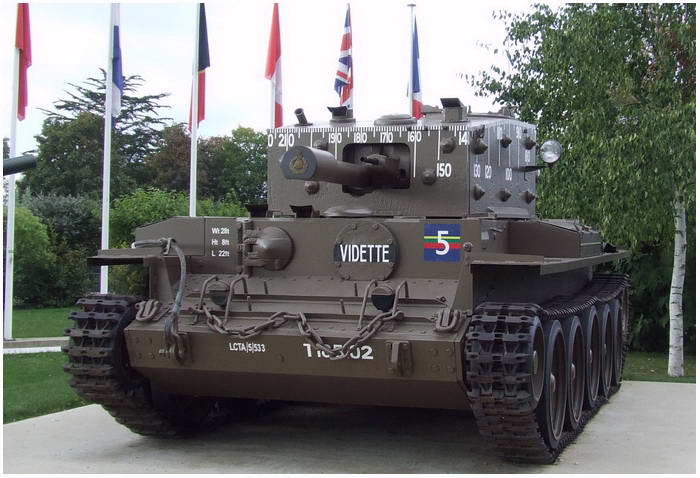
The Centaur IV at the Memorial Pegasus Museum
In 2014 the Centaur IV which stood for years across the road from the café of the family Gondrée,
has been moved to the museum. Of this type, with 95mm gun, 80 were built and were deployed by the
Royal Marine Armoured Support Group to operate from LCT's in support of the landing parties. To coordinate the
shots at targets, the turret had markings to line the gun towards them. The LCT's were in the waves no
steady platform, and the Centaurs were dropped onto the beaches instead and started their work from there.
(Opposite the café, on the spot where once the Centaur IV stood, is now a Bofor AA gun to be found).
For more pictures on the battle around Pegasus Bridge
CLICK HERE
FROM PEGASUS BRIDGE TO RANVILLE (D 514).
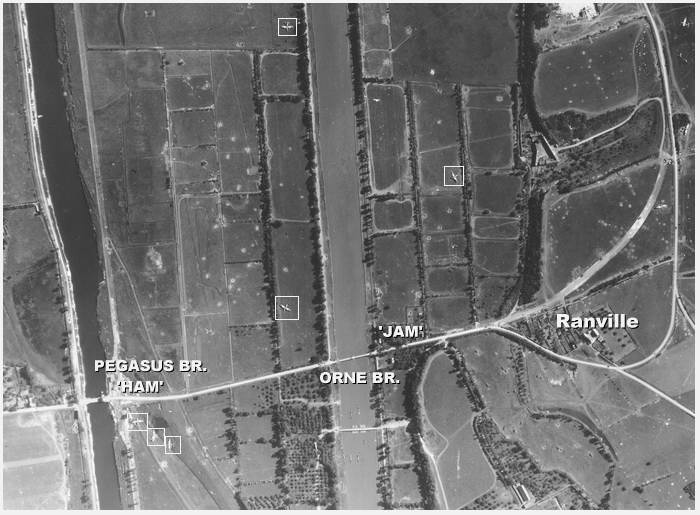 The two bridges were taken just after midnight on June 6th, 1944.
The two bridges were taken just after midnight on June 6th, 1944.
In the white squars the positions of the Horsa gliders,
(notice the great distances for
the Orne ('Jam') bridge)
It is a short drive towards Ranville. Take the first roundabout after the the bridge across the Orne (the second one
and on June 6th, 1944 known as 'JAM') and head for Mervill/Franceville. After a few hundred meters, after the slow corner,
make a stop on the right-hand side of the road near the small monument. This point was one of the LZ's (landing Zone) for
the gliders. To the south of the monument one Horsa made a landing on the V-shaped field. But most of the gliders landed
north and east of this point.

Turn sharp right and head for Ranville. In front of you, appears the detached belltower of the church of Ranville.
Behind this church is the war cemetery for mainly the 6th Airborne Division. There are 2563 white markers on this site.
Behind the northern church wall are a few men buried that were killed in the first two days of the landing. Among them Lt.
Brotheridge, who was one of the first soldiers to die on that day. He was killed near the Pegasus Bridge. The
family Gondrée, owners of the Café near the bridge, honoured him with a plaque. Here at the churchwall
is also a lonely grave of an unknown German soldier.
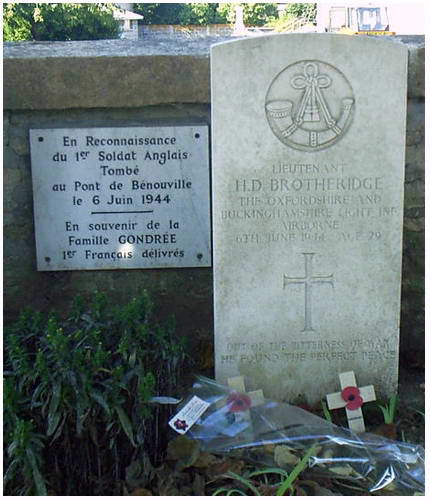  The grave of Lt. Brotheridge and the bust of General
Gale
The grave of Lt. Brotheridge and the bust of General
Gale
East of the church is a boy-and girl school. On the far site, near the libary stands the bust of Major-General R.N.
'Windy' Gale. Gale, commander of the 6th Airborne Division, was flown in by glider around 03.30 hours and he put up his
HQ in Ranville. On the way to Ranville, he confiscated a white horse and made good use of it. One day it saved the live
of Gale when it stood between the General and a falling mortar shell.
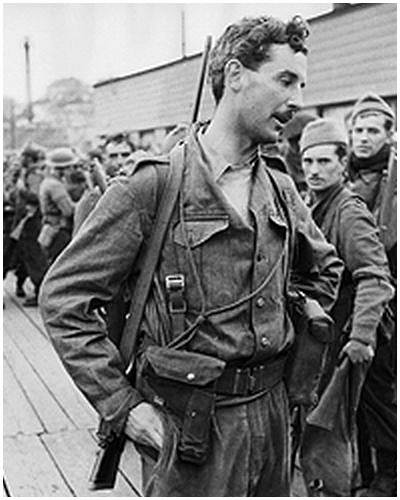 Lt-Col. Lord Lovat
in 1942 after Operation Jubilee (the Dieppe Raid)
Lt-Col. Lord Lovat
in 1942 after Operation Jubilee (the Dieppe Raid)
Ranville was heavily attacked by the German forces,
and when Lord Lovat reached the Pegasus Bridge that afternoon, he and his man were directed to Ranvill. Six days later
Lovat was seriously wounded during an attack through Amfréville.
CONTINUE THE ROAD NORTH, TOWARDS MERVILLE/FRANCEVILLE AND CABOURG (D 514).
On your way to Merville, you can make a small detour through the lovely little town
of Amfréville. Central in the town stands the impressive church. Because a couple of roads
ran into this town, it was a important tactical crossroad.

One of a couple of monuments in Amfréville
(in the back stands the church)
After the liberation of Amfréville on 6 June by the 6th Airborne, the 4th
Commando from Kiefer took it over from the British paratroopers. After a heavy battle on
8 June, around Bréville, Lord Lovat had to pull back to Amfréville and spent the night
with his men in the church.
6 JUNE 1944, 00.20 HOURS, OBJECT:
MERVILLE
BATTERY.

Just in the south, outside Merville, lies the battery complex that the
Allies were afraid off because the bunkers were to contain
150mm cannons that could be a danger for the invasion fleet.
The task to silence the complex was given to Lieutenant Colonel Terence
Otway. Lancaster bombers dropped bombs just after midnight on
the battery. Unfortunately the bombs missed the target.
 
Lt. Colonel Terence Otway, right, his
signature (own coll.)
Four hours after the paratroopers of the 6th Airborne Division landed
Otway collected 150 men and did head for the Merville. This
was just 25% of the men that made the jump. The most of them
were hopelessly lost or were dropped at the wrong point. The
attack started at 04.20 hours which was fierce and bloody.
Seventy British soldiers were killed or wounded. At the German
garrison twenty were captured, the other Germans were killed
or wounded. At 05.00 hours it was all over. In the bunkers
were not the dreaded 150mm but some 100mm Skoda cannons. After
Otway and his men left the site the battery was once more
taken by the Germans. The next day there was again hefty
fighting in the bunkers and the tunnels that connected the
bunkers.

THE MUSEUM:
In the first casemat, the biggest of the battery, an impressive sound- and
light show is presented. When the green light near the entrance is illuminated you
may enter the casemat. The ‘show’ is in two parts. The first segment consists of the
shooting of the heavy gun at the invasion fleet. Around the gun stand a couple of German
(puppet) soldiers. The enormous noise might frighten little children and the smoke makes
the environment very sinister. The second part is the attack by the para’s under the command
of Otway. Beside the show, there are a few small rooms with diorama’s which shows how German
troops lived in this casemat.

The concrete of the first casemat has
a nice pattern around the tobruk
The British paratroopers who made the attack on this battery are the focus of
the exhibition in the second casemat. There are some personal items on show,
such as documents, pictures and medals. Also in this casemat are small diorama’s
which show how the British para’s did their work over here.

The medals of Lieutenant Colonel Terence Otway
There are some broken pieces of concrete, but extreme evidence of damage by fighting is scares.
What obvious is how the casemats are built. The outer skin has a very interesting pattern of camouflage.
The big commando bunker can not be visited and stands knee deep in water. On this bunker some evidence
of the fighting is noticeable, bullet holes in the concrete and grenade blasts around the entrances.
The command bunker had a periscope in the roof. During the attack in the night of 6 June, Stabsfeldwebel
Buskotte looked through the periscope when a British paratrooper took a shot at it and made it unusable.

During 2008 an original D-Day veteran was placed at the museum, a C-47
In July 2008 an original C-47 was placed at the museum. This Dakota, the 43-15073, brought
in the night of June 5-6, 1944, paratroopers from the 501st PIR, 101st Airborne Division, to France where they
jumped south of Ste-Mère-Eglise. In September 1944 she brought troops from the 82nd Airborne to
Holland during Operation Market-Garden. On 27 December, 1944 she was hit bad by German Flak
over Bastone during the battle of the Bulge. The crew almost went down with her, but escaped with
their lives.
  The C-47, 43-15073 SNAFU with
one of her pilots; James P. Harper
The C-47, 43-15073 SNAFU with
one of her pilots; James P. Harper
After the war she was in service with the Czechoslovakian
airlines and later in the French Air Force. After that she was sold to the Yugoslavian A.F. and saw action
during the Baltic conflict and was badly damaged by machine gunfire. She was saved from the axe and
completely restored and is placed as a memorial at the museum in Merville.
FOR THE NEXT STAGE OF THE TOUR, YOU MAY TURN BACK
FOLLOW THE SIGNS AND GO TOWARDS OUISTREHAM
Clik below on:
BRITISH AND CANADIAN SECTORS;
'Sword, Juno and Gold'.
|